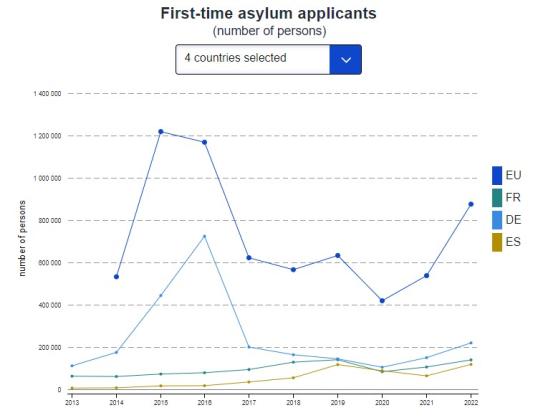
Migration and asylum policy has been attracting considerable public attention and is expected to play a decisive role in the upcoming European elections, especially after the adoption of the Pact on Migration and Asylum by the European Parliament in early April. In this context, Eurostat’s new interactive publication on migration and asylum could come in handy, allowing citizens to check the facts and keep inaccuracies and half-truths from disseminating.
For instance, did you know that, in 2022 most people in the EU lived in their country of citizenship, and only 8% (37 million people) of the EU population were citizens of another country than their country of residence? 3% were citizens of another EU country and 5% of a non-EU country. The same year, all EU countries combined granted protection status to 384 000 asylum seekers, up by 39% compared with 2021 (275 000). Almost half of all residence permits issued in the EU were for work and education purposes (49%), 26% were for family reasons, and only 25% were granted for other reasons such as international protection. Moreover, around 74 000 non-EU citizens were returned outside the EU, following an order to leave the territory of a specific EU country.
Visualising topical data at EU and national level
One of this interactive publication’s many strengths is that it allows visitors to compare national data with overall EU data. For instance, when comparing the overall number of first-time asylum applicants in the EU, from 2013 to 2022, with the equivalent data for Germany, France and Spain, the countries with the highest numbers of first-time asylum applications in 2022, you see that EU and national data do not always reflect each other.
The publication also focuses on topical areas, such as migration to, within and from the EU, residence permits, asylum decisions, temporary protection, irregular migration and returns among other topics, while giving prominence to migrants’ skills – more specifically, the EU’s ability to attract skills and talent, as well as the overqualification of migrants.
Visit the Migration and asylum in Europe – 2023 interactive publication to find out everything you need to know on the latest data, to explore, visualise and compare indicators on migration and asylum at EU and country level.
Find out more
Migration and asylum in Europe – 2023 interactive publication
Details
- Publication date
- 19 April 2024
- Author
- Directorate-General for Migration and Home Affairs

